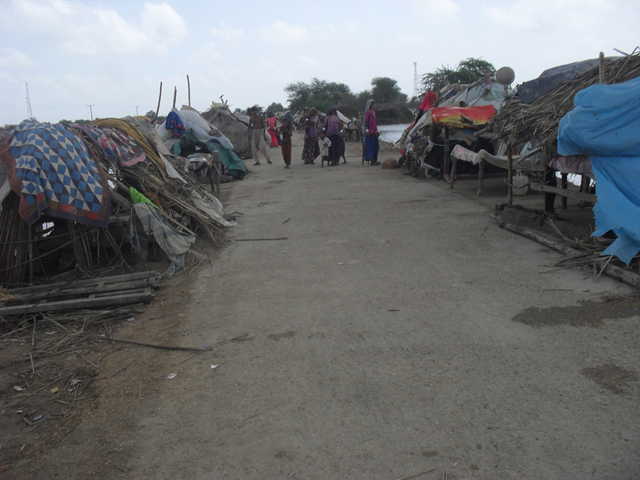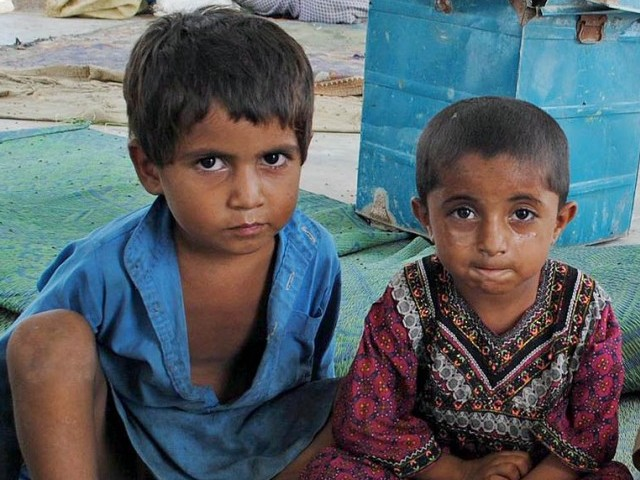Winter brings more misery to millions of Pakistan flood victims
 [It’s amazing that for all the bloviating on Pakistan during the parade of belligerent ignorance at this week’s Republican national security “debate”, the catastrophic flooding of 2010 and 2011 wasn’t mentioned once.]
[It’s amazing that for all the bloviating on Pakistan during the parade of belligerent ignorance at this week’s Republican national security “debate”, the catastrophic flooding of 2010 and 2011 wasn’t mentioned once.]
ISLAMABAD – More than two months after the August floods hit the southern Pakistan, millions of affected people are still at great risk as the winter season approaches fast, Fadlullah Wilmot, the country director of Islamic Relief Pakistan, said here on Wednesday. Wilmot said the last monsoon floods affected the lives of over 9 million people, who had earlier faced the previous year’s floods of greater magnitude. “Millions of homes in Sindh, the worst hit province of the country, have been destroyed or damaged. In its 2011 flood response programme, the Islamic Relief Pakistan, with an allocation of 10 million pounds, tried to address the early recovery, healthcare, livelihood, nutrition, water, sanitation and hygiene needs of the flood-affected population of Sindh,” he added. He said the fast approaching winter season would bring more misery to those long-suffering people since the cold weather required adequate shelter and warm clothing for over 800,000 people, still displaced from their homes. “Millions of flood-affected poor people, who have managed to find some sort of shelter need blankets and warm clothes to protect themselves against the harsh and cold conditions,” Wilmot voiced his concerns. In addition to those mounting problems, he said, the funds raised, so far, had been extremely low. “The UN has only managed to raise $96.5 million against its $357 million appeal. Aid agencies operations are also dangerously under-funded. It’s worrying how poor the response has been to the efforts to raise funds in the wake of this humanitarian crisis. Without adequate funds, we won’t be able to reach many of those affected by this year’s floods; particularly the vulnerable including women and children. We need more funds to do vital, lifesaving work,” he added. He observed that the adequate nutrition was still a major problem in the flood-wreaked areas since at least thirteen districts of Sindh saw more than 67 per cent of their food stocks destroyed and 30 per cent of children suffering from severe malnutrition. This time of the year, which is the sowing season for wheat, the land of hundreds of farmers is still inundated with the floodwater, he added.
Winter brings more misery to millions of flood victims 
ISLAMABAD, November 24 (PPI) – More than two months after the August floods, millions of people are still at great risk as humanitarian problems in the country continue to mount, said Fadlullah Wilmot, the director of an NGO, Islamic Relief, here on Wednesday. He said that over nine million people have been affected by the monsoon floods which hit slightly over a year after the devastating floods of 2010. Millions of homes in Sindh, the worst hit region in the country have been destroyed or damaged. In its 2011 flood response programme, Islamic Relief Pakistan, with an allocation of 10 million pounds, addressed the early recovery, healthcare, livelihood, nutrition, water, sanitation and hygiene needs of the flood-affected population of Sindh. Despite these mounting problems, the funds raised for this year’s floods in Pakistan so far has been extremely low. The UN has only managed to raise $96.5 million for its $357 million appeal. Aid agencies operations are also dangerously underfunded Adequate nutrition is still a major problem in the country – thirteen districts in Sindh saw more than 67 per cent of their food stocks destroyed and 30 per cent of children in Sindh are suffering from severe malnutrition. This time of year is also planting season, but as the fields of many farmers are still under water which will further prolong and compound the problem of hunger and poverty.
Floods 2011: 30% of children suffer from malnutrition
ISLAMABAD, November 23 (Pakistan Today) – The National Disaster Management Authority (NDMA) on Wednesday said that it received only 35 percent of the amount pledged by world donors after a United Nations appeal for Pakistani flood victims, and that it would soon launch a fresh appeal to meet its requirement of $400 million. NDMA Chairman Dr Zafar Qadir, while addressing a press conference, said the UN had asked the world community in September to provide $356 million for the flood victims, but the world remained skittish in donating the money. Qadir said the NDMA had curtailed some of its projects due to shortage of funds, adding that the provinces would now prioritise the projects and provide a list of crucial projects within a week. He said the NDMA had cut down the management fee of the UN and other international agencies from 25-30 percent to 15 percent of the aid money. Giving details of the revised Response Plan, the NDMA chairman said the total affected population was 5.15 million, with 4.82 million in Sindh and 0.332 million in Balochistan. He added that around 16 percent of the affected families were still living in temporary shelters due to several reasons, and that around 76 percent of the families required shelter in order to start a normal life again regardless of the fact that they were living in refugee camps or their broken houses. He said the floods had damaged 800,000 houses, of which 330,000 were completely destroyed. He added that 2,000 health facilities in Sindh and Balochistan were either damaged or completely destroyed in the recent floods. Qadir also informed that Malaria and Diarrhoea were the most common diseases in the flood affected areas and that the NDMA would need international assistance to combat the outbreaks. About agricultural losses, the NDMA chairman said that crops over 2.28 million acres were destroyed and around 116, 557 heads of cattle had perished in the floods. According to the revised figures, approximately 9,781 schools were damaged in Sindh and Balochistan, affecting the education of one million children.
NDMA received only 35pc of pledged flood aid, new appeal coming soon 
November 23 (Plan International) – Farmer Noor Muhammad was hit with the worst disaster in nearly five decades of his life when the monsoon rains and floods in August/September destroyed his home and damaged his rice and cotton crops in a remote village in Pakistan’s southeastern province of Sindh. Left in heavy debt with inundated waters in his 20 acres of spoiled cotton and rotten paddies, Muhammad isn’t sure what to do next as his loan shark is demanding some interest repayment, which is charged at a monthly rate of 10 percent for the principle of 450,000 rupees (USD 5,150). “I have lost all my crops and am now left with a big pile of debt,” says father-of-six Muhammad in the arid village of Qaim Khan in the disaster-prone district of Badin. “I can’t grow anything as the flood water is not receding and I have no money to buy seeds. I may have to sell some livestock to repay some debt and borrow a bigger loan for a new crop. Or I will have to look for a labour job in town to repay some loan and borrow a bigger one.” Muhammad is among 3 million flood-hit and food-insecure people in districts of Sindh and adjacent province Balochistan who urgently require agricultural support to enable them to resume food production and income-generation activities, the UN humanitarian office OCHA said in its Nov 18 situation report. Even if the situation improves, Muhammad, like tens of thousands of other flood-hit farmers in Sindh, will be late for the new planting season, which means the yields will be significantly lower than if they had started planting on time. Every planting day missed after the optimum planting period (15 November for early planting; 1 December for late) may result in the loss of 16 kg of wheat per acre per day, according to the UNOCHA situation report. “If donor funds are received in the next few days, they could be used to procure wheat seeds for many families who would otherwise be unable to harvest this staple crop again until March 2013,” the report said. UN agencies and other global aid organisations such as Plan International are rushing to raise sufficient funds to respond to the 2011 monsoon floods in Pakistan, which is still reeling a year on from its worst flooding in history, in which nearly 20 million people lost their homes, farmland and were displaced. This year heavy rains and floods in late August and early-September have killed some 200 people and made 6.8 million homeless or displaced across Pakistan. Out of those affected people, 1.8 million of them live in Badin, the worst-hit region. But the funding effort was an uphill battle for most INGOs and UN agencies as they are competing against other high-profile disasters from the same funding sources. The Pakistan Floods Rapid Response Plan, drafted by the Pakistani government, UN agencies and international aid agencies and launched in mid-Sept, requested USD 357 million from the international community to support an estimated 5.8 million flood-hit people for six months. But two months after the launch, most agencies were able to raise roughly a third of what they need. The food security cluster’s requirement accounts for the largest part of the response plan, but only 37 percent of the required $174 million fund was met as at Nov 18, according to the UNOCHA report. Earlier this month, Oxfam, Save the Children, Care and ACTED, urged the donor community to step up its response to the 2011 floods in Pakistan as over nine million people who have been affected by severe flooding in Sindh are at risk of disease and widespread malnutrition, while relief efforts reaching over five million people are under threat due to lack of funds. Plan International, which has raised $2.7 million out of 6.3 million required to benefit close to 150,000 people, is also concerned that it may have to scale back its work on food security, education, shelter and water & sanitation proportionately, if the required funding is not met. Apart from dried food distribution that Plan is working with the World Food Programme, it is awaiting funding approvals from other UN agencies to provide some short-term paid work for flood-hit villagers and to help farmers repair broken canals to bring waters to their farms. “Thousands of families have been affected by the floods and are in desperate need of assistance. But if we don’t get the funding we require, we won’t be able to assist those people to the best of our abilities,” said Plan Pakistan acting country director Rashid Javed. Whether Noor Muhammad, who is already among the 80,000 people Plan and local partner HANDS are providing 200,000 liters of safe drinking water to daily, will be able start his new planting season depends on whether Plan and other aid agencies will receive the funding they need.
Aid Worker Diaries – Funding shortage threatens food security in flood-hit Pakistan